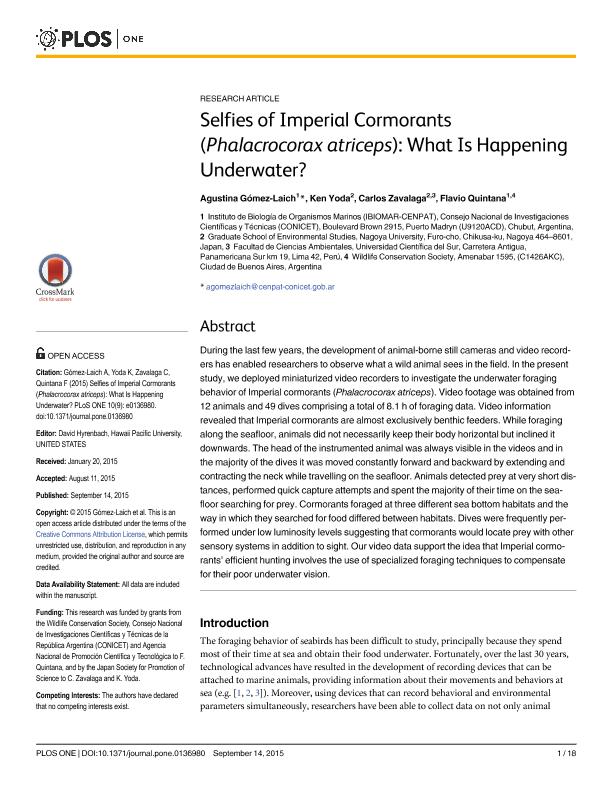Artículo
Selfies of imperial cormorants (Phalacrocorax atriceps): What is happening underwater?
Fecha de publicación:
09/2015
Editorial:
Public Library of Science
Revista:
Plos One
ISSN:
1932-6203
Idioma:
Inglés
Tipo de recurso:
Artículo publicado
Clasificación temática:
Resumen
During the last few years, the development of animal-borne still cameras and video recorders has enabled researchers to observe what a wild animal sees in the field. In the present study, we deployed miniaturized video recorders to investigate the underwater foraging behavior of Imperial cormorants (Phalacrocorax atriceps). Video footage was obtained from 12 animals and 49 dives comprising a total of 8.1 h of foraging data. Video information revealed that Imperial cormorants are almost exclusively benthic feeders. While foraging along the seafloor, animals did not necessarily keep their body horizontal but inclined it downwards. The head of the instrumented animal was always visible in the videos and in the majority of the dives it was moved constantly forward and backward by extending and contracting the neck while travelling on the seafloor. Animals detected prey at very short distances, performed quick capture attempts and spent the majority of their time on the seafloor searching for prey. Cormorants foraged at three different sea bottom habitats and the way in which they searched for food differed between habitats. Dives were frequently performed under low luminosity levels suggesting that cormorants would locate prey with other sensory systems in addition to sight. Our video data support the idea that Imperial cormorants' efficient hunting involves the use of specialized foraging techniques to compensate for their poor underwater vision.
Palabras clave:
Imperial Cormoran
,
Video Cameras
,
Underwater Foraging Behaviour
Archivos asociados
Licencia
Identificadores
Colecciones
Articulos(IBIOMAR)
Articulos de INSTITUTO DE BIOLOGIA DE ORGANISMOS MARINOS
Articulos de INSTITUTO DE BIOLOGIA DE ORGANISMOS MARINOS
Citación
Gómez Laich, Agustina Marta; Yoda, Ken; Zavalaga, Carlos; Quintana, Flavio Roberto; Selfies of imperial cormorants (Phalacrocorax atriceps): What is happening underwater?; Public Library of Science; Plos One; 10; 9; 9-2015; 1-18; e0136980
Compartir
Altmétricas




